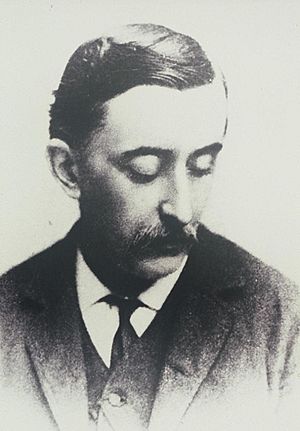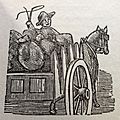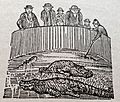Lafcadio Hearn facts for kids
Quick facts for kids
Lafcadio Hearn
Koizumi Yakumo (小泉八雲) |
|
|---|---|

Lafcadio Hearn in 1889 by Frederick Gutekunst
|
|
| Born | Patrick Lafcadio Hearn; Πατρίκιος Λευκάδιος Χερν 27 June 1850 Lefkada, United States of the Ionian Islands |
| Died | 26 September 1904 (aged 54) Tokyo, Japan |
| Pen name | Koizumi Yakumo |
| Language | English, Greek, Japanese |
| Nationality | Irish, Greek, Japanese |
| Alma mater | Ushaw College, University of Durham, England |
| Spouse | Alethea ("Mattie") Foley Koizumi Setsu |
Patrick Lafcadio Hearn (Greek: Πατρίκιος Λευκάδιος Χερν; born June 27, 1850 – died September 26, 1904) was a famous writer. He is best known for his books about Japan, especially his collections of Japanese legends and ghost stories. One of his most famous works is Kwaidan: Stories and Studies of Strange Things. In the United States, Hearn also wrote about the city of New Orleans. He later took on the Japanese name Koizumi Yakumo (小泉 八雲).
Contents
Life of Lafcadio Hearn
Early Years
Lafcadio Hearn was born on June 27, 1850, on the Greek island of Lefkada. He was named after the island. His father, Charles Bush Hearn, was an Irish soldier, and his mother, Rosa Antoniou Kassimatis, was Greek.
Moving to Ireland
When Lafcadio was young, he moved from Greece to Ireland. He had a difficult childhood. First, his mother left him with his father's aunt, Sarah Brenane. Then, his father also left. Finally, his aunt, who was supposed to take care of him, also stopped supporting him.
In 1857, when he was seven, his great-aunt Sarah Brenane looked after him. Hearn loved to explore her library. He read many Greek stories, especially myths.
School Days
In 1861, Hearn's aunt sent him to a Catholic school in France. He learned to speak French very well there. Later, he would translate books by French writers into English.
In 1863, he went to Ushaw College, a Catholic school in England. When he was 16, he had an accident in the schoolyard. He hurt his left eye, and it became infected. He lost sight in that eye and also had poor vision in his other eye. Because of this, he often tried to hide his left eye.
By 1867, his aunt and her financial manager lost all their money. There was no money for Hearn's school. He was sent to London to live with a former maid. She and her husband had little time or money for him. Hearn struggled and spent time visiting libraries and the British Museum to learn.
Life in America
In 1869, Hearn got a ticket to New York. He was told to go to Cincinnati to find his aunt's relatives. He arrived with very little money and had to work hard for a place to stay.
Hearn lived in New Orleans for almost ten years. He worked for different newspapers and magazines. He also translated books from French into English. He wrote an important article in 1883 about Filipinos living in the United States, called the Manilamen or Tagalogs. He visited one of their villages in Louisiana.
Travels to the West Indies
In 1887, a magazine called Harper's sent Hearn to the West Indies as a writer. He spent two years in Martinique. During this time, he wrote for the magazine and published two books: Two Years in the French West Indies and Youma, The Story of a West-Indian Slave. Both books came out in 1890.
Later Life in Japan
In 1890, Hearn traveled to Japan as a newspaper writer. He found a new home and great inspiration there. He got a job teaching at a school in Matsue, Shimane. Today, the Lafcadio Hearn Memorial Museum and his old home in Matsue are popular places for tourists.
In Matsue, Hearn married Koizumi Setsu, whose family were samurai. They had four children together. In 1896, he became a Japanese citizen and changed his name to Koizumi Yakumo. He had been Greek Orthodox and Roman Catholic, but later he became a Buddhist.
In late 1891, Hearn started teaching in Kumamoto, Kyūshū. He worked there for three years and finished his book Glimpses of Unfamiliar Japan (1894). In 1894, he became a journalist for an English newspaper in Kobe. From 1896 to 1903, he taught English literature at Tokyo Imperial University. In 1904, he became a professor at Waseda University.
Lafcadio Hearn died on September 26, 1904, at the age of 54, from heart failure. His grave is in the Zōshigaya Cemetery in Toshima, Tokyo.
In the late 1800s, many people in Western countries didn't know much about Japan. But after the Exposition Universelle of 1900 in Paris, Japanese styles became popular. Hearn's books helped people in the West learn about Japan before it became very modern. His writings are still important because they describe Japan during the Meiji Restoration period.
Works by Lafcadio Hearn
Books about Japan
- Glimpses of Unfamiliar Japan (1894)
- Out of the East: Reveries and Studies in New Japan (1895)
- Kokoro: Hints and Echoes of Japanese Inner Life (1896)
- Gleanings in Buddha-Fields: Studies of Hand and Soul in the Far East (1897)
- The Boy who Drew Cats (1897)
- Exotics and Retrospectives (1898)
- Japanese Fairy Tales (1898, and sequels)
- In Ghostly Japan (1899)
- Shadowings (1900)
- Japanese Lyrics (1900)
- A Japanese Miscellany (1901)
- Kottō: Being Japanese Curios, with Sundry Cobwebs (1902)
- Kwaidan: Stories and Studies of Strange Things (1903, later made into the movie Kwaidan)
- Japan: An Attempt at Interpretation (1904)
- The Romance of the Milky Way and other studies and stories (1905)
Books about Louisiana
- La Cuisine Creole: A Collection of Culinary Recipes (1885)
- Gombo Zhèbes": A Little Dictionary of Creole Proverbs, Selected from Six Creole Dialects. (1885)
- Chita: A Memory of Last Island (1889)
- Creole Sketches (1924, Houghton Mifflin)
Other Works
- One of Cleopatra's Nights and Other Fantastic Romances (1882, translation of stories by Théophile Gautier)
- Stray Leaves From Strange Literature; Stories Reconstructed from the Anvari-Soheili, Baital Pachisi, Mahabharata, Pantchantra, Gulistan, Talmud, Kalewala, etc.(1884)
- Some Chinese Ghosts (1887)
- Youma, the Story of a West-Indian Slave (1889)
- Two Years in the French West Indies (1890)
Images for kids
-
Plaque on Hearn's home on Gardiner Street, Dublin
-
Hearn's former home on Cleveland Avenue in New Orleans is preserved as a registered historic place.
See also
 In Spanish: Lafcadio Hearn para niños
In Spanish: Lafcadio Hearn para niños










